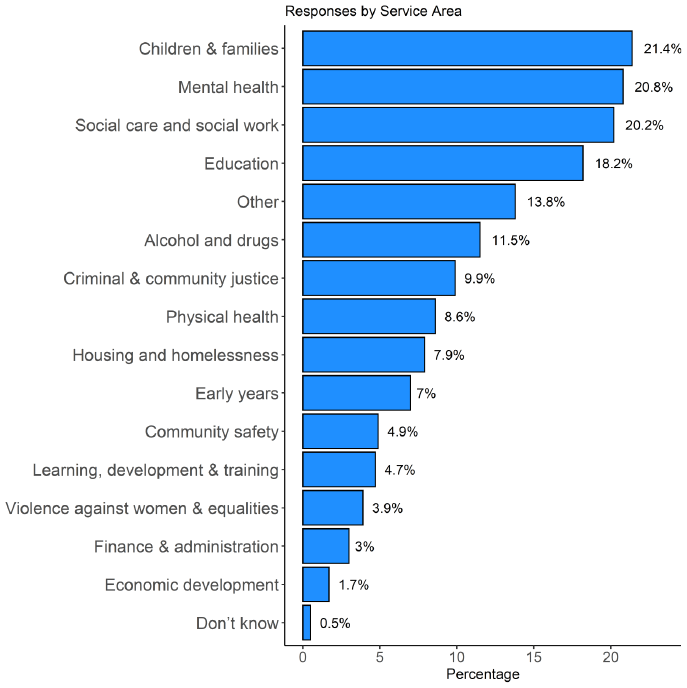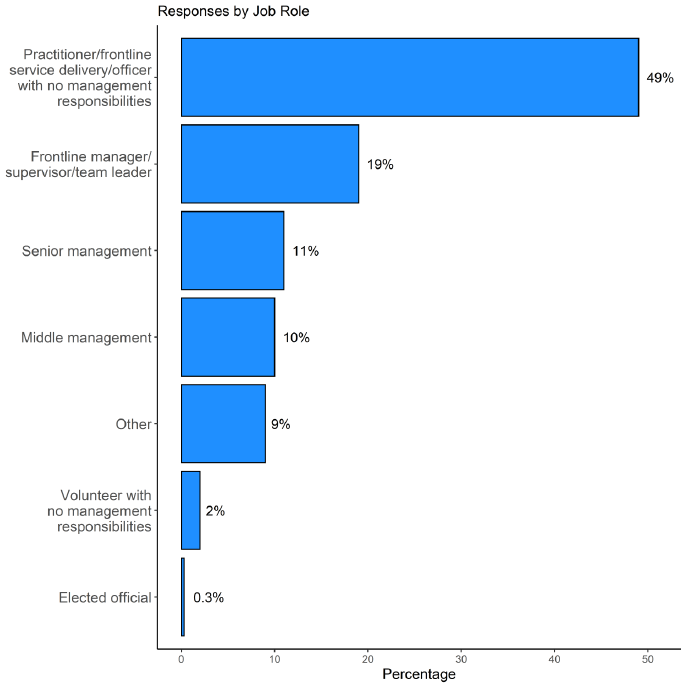National Trauma Training Programme: workforce survey 2021
Main findings from an online survey of the Scottish workforce exploring awareness and attitudes to psychological trauma and trauma-informed practice. The survey was carried out by the Improvement Service as part of the National Trauma Training Programme.
2. Aims and methods
Aims of the research
2.1 The aim of this research was to measure the self-assessed levels of confidence, knowledge, skills and understanding across different sectors of the workforce of psychological trauma and trauma-informed practice. In addition, the research aimed to capture the uptake of National Trauma Training Programme resources, and a measure of the extent to which individuals felt that the key drivers of trauma-informed practice had been embedded within their organisation.
Methods
2.2 Data was collected through an online survey issued over a two-week period from 19 February to 5 March 2021.
2.3 In recognition of the demands on the workforce, particularly in light of the impact of COVID-19, the survey was deliberately kept as short, easy to answer and accessible as possible. In total, 13 questions were included in the survey. These questions were developed by the Improvement Service in consultation with stakeholders. The full list of survey questions is available in Annex A.
2.4 The sampling frame for the survey was all employees within Scotland across the public and third sectors, as well as those working within the private social care sector. In order to reach as wide a sample of employees within these sectors as possible, the survey was distributed through a range of networks and groups. Distribution of the survey took place using several digital means including email, Teams, Twitter, newsletters and the Improvement Service website.
Respondent characteristics
2.5 The survey received 3553 responses, a strong response given the short timescales and context of the pandemic, and a good sample size for assessing levels of awareness within the workforce. Respondents were initially asked a series of questions about their area of employment including the local authority areas that they worked in, the sector and service areas that they worked within and their job role.
2.6 All categories for each of these sections were represented, including responses from all 32 local authority areas. A majority of respondents worked in the public sector (71.8%) with around 17% from the third sector and 7% from the private sector. A small number of respondents indicated that they were currently unemployed or worked across several sectors.
2.7 Respondents were also asked to select which service area they currently work in. A list of areas was provided with the option to select multiple services if appropriate. The most frequently selected were children and families (21.4%), mental health (20.8%), social care and social work (20.2%) and education, including higher education (18.2%). A number of respondents worked in services not included within the list of options including data and digital, roads and transportation, and legal services. The breakdown by service area is displayed in Figure 1.
2.8 It should be noted that not all service areas were equally represented across the third, public and private sectors. Social care and social work, for example, was represented to a greater extent in the private sector at 29.4%. This was the main service at which this survey was aimed in the private sector.
2.9 There were also several service areas with higher representation within the third sector including alcohol and drugs, children and families, mental health, and housing and homelessness.
2.10 Results for the public sector generally mirrored the breakdown across the full sample, although education was slightly overrepresented. Where comparisons are made between sectors, it is important to note that the samples for each differ and may in part explain some of the differences in responses. Additionally, given the varied sample sizes, some subgroup results have relatively large confidence intervals and associated margins of error.

2.11 The final question on respondent characteristics asked about job role with reference to direct management responsibilities. Almost half of respondents (49%) described their role as "Practitioner/frontline service delivery/officer with no management responsibilities". Just under 19% indicated that they were a "Frontline manager/supervisor/team leader", around 11% indicated that were senior management and 10% were middle management. A small number of elected officials and volunteers without management responsibilities also completed the survey. The role breakdown is displayed in Figure 2.

Caveats and limitations
2.12 There is likely to be some sample error within responses, particularly non-response bias where some respondents may not have felt the topic was relevant. Although a large number of responses were received from a wide range of sectors and services, certain services have high representation, most likely among those areas where employees are already engaged with trauma-informed practice or the concept of trauma, such as in mental health. However, as discussed below, there were also many respondents with low levels of self-assessed confidence and who had not engaged with the NTTP or other training resources. It is, therefore, reasonable to assume that the responses capture the views of those who may not consider themselves engaged with the NTTP or trauma-informed practice. In addition, respondents were able to select multiple service areas, therefore percentages displayed within this report are calculated using the number of respondents and in some cases may total more than 100%.
2.13 Care should also be taken in comparing subgroups based on sample size. Smaller samples are less precise, with wider confidence intervals. This is particularly true in comparing service areas, where some areas had small numbers of responses. Comparisons between groups within this report take account of sample size and where differences are statistically significant, this is highlighted.
2.14 It should also be noted that some local authority areas are better represented than others. This is possibly due to additional efforts to promote the survey at a local level in some areas and, while it could suggest additional levels of engagement or belief that the survey was relevant, there is no reason to believe this would skew the results.
Contact
Email: ACEstrauma@gov.scot
There is a problem
Thanks for your feedback